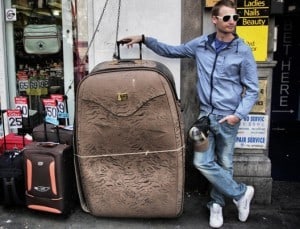Last Updated on October 10, 2024 by Aswetravel
Conscious Traveling – Tourism can contribute to the positive development of many countries, but in order to make this happen, we as travelers need to take some responsibility.
Just traveling to a country and seeing the poverty doesn’t really make much difference, we also need to be prepared to take some action.
I’m not talking about charity and volunteering this time, no this is much simpler than that.
By taking some responsibility I mean putting some pressure on the Western tourist industry.
Making a difference and helping a country doesn’t have to equal making a big effort, all it takes is that we raise our standards and won’t accept or support tourist companies who abuse their power and ignore human rights.
The tourist companies will bend over backwards to keep their customers happy.
As long as we’re happy and pleased, they’re happy.
If we accept their actions they will continue doing what they do.
We should use our power as customers!
Understand the Challenges Your Vacation Locales Face
First of all, we have to know what’s really going on behind the scenes.
We can’t change something if we don’t know what’s wrong first, right?
In this blog post I share the bad side of tourism, and what we all can do to make a small difference.
The big restaurants, hotels, and hotel chains are often built and managed by international companies.
The locals see and gain very little of the income from the tourism.
Instead the money goes to the Western tourist companies outside the country.
It’s true that the tourist industry creates a lot of jobs for people, but the working conditions are often poor.
The local work that the tourist industry creates are often low paid (so much so that they often find it hard to survive) and it’s not uncommon that you can also find children working.
According to the “Tourism Concern” charity, trekking porters carrying the heavy supplies for tourists in trekking destinations like Nepal are an example of jobs created by the tourist industry with very bad working conditions.
Traveling Creates Lack of Water in Many Countries
Hotels with big swimming pools, showers, lawns, and golf courses need loads of water every day.
In places where there is a limited amount of freshwater such as islands and coastal areas, the hotels’ massive use of this creates severe consequences for the locals.
Trafficking and Child Prostitution
A big problem in the tourist industry is the growth of sex tourism.
The trading of women’s and children’s bodies is huge in countries like Thailand and Brazil, and because it’s the third most profitable business in the world, you can find that it’s just getting worse and worse.
Alcohol and Drug Consumption
This is about the tourists’ attitude on their travels.
There is a reason why many locals don’t like tourists and have made up assumptions of us being violent, rude, and disrespectful drunks.
If that’s all they see, why would they ever want to get to know us?
It’s so sad coming to a place where people already have negative assumptions of you because you’re a tourist.
So please, make a good impression!
Eco-Friendly Tour Options Waiting for You
Many people are fascinated by green travel and eco-friendly tours.
Essentially, this involves respecting the environment by making responsible and sustainable choices.
One of the best ways to accomplish this goal is by signing up for an eco-friendly tour.
Thanks to the booming popularity of green travel, it’s possible to find these tours almost anywhere.
Whether your travels take you to the other side of the world or to the other side of town, chances are good that there are environmentally friendly touring options just waiting for you.

Eco-Friendly Tour Ideas
Consider signing up for a guided tour that relies upon an alternative means of transportation.
Segway tours in cities like Atlanta, San Francisco, and Washington, D.C. are readily available.
Each tour is unique, enabling you to discover some of the major sights in each city without the use of fossil fuels.
These tours generally last from one to three hours, and small group sizes ensure plenty of one-on-one interaction with the knowledgeable guide.
Even if you choose to travel alone, a group or self-guided tour is something to consider.
In addition to tours that show you the major attractions, look for special or seasonal tours.
Some companies offer tours for viewing holiday lights or for seeing the leaves change color in the fall.

If the Segway doesn’t appeal to you, bicycling is another eco-friendly tour option.
Bicycling tours are very popular in Europe and to a lesser extent the U.S.
While many such tours require that you power your bike with your legs, others provide an electric bike to make the going a little easier.
You’ll be able to climb hills with ease while riding this green transportation option.
Some countries have elevated the principles of the eco-friendly tour to high art.
One of these is Costa Rica.
With its lush jungles and tremendous diversity of wildlife, this Central American country is an ideal spot for green travel.
You can stay a various nature retreats, which are found deep in an unspoiled forest, and book amazing explorations through an organization which specializes in environmentally friendly tourism.

Nepal is another destination that provides a broad array of environmentally responsible tourism options.
There are many organizations that specialize in eco-tourism itineraries, making it possible for you to explore the culture and landscape in a safe, sustainable manner.
From wildlife safaris to canoeing or trekking, these adventures are designed to be remembered for a lifetime.
Choose an eco-friendly tour the next time you travel for a journey that is as sustainable as it is memorable.
Eco friendly Bicycle ToursWhat You Can Do To Travel More Consciously
Here are six tips from Flights.com to help you conscientiously explore the Earth. Charity Giving
Before You Travel
Ask about the working conditions for the employees in the hotel you’ll be staying in.
Ask about the hotel’s work with the environment; is the drain water cleaned?
How do they manage waste products?
Ask your travel agency how they counteract prostitution and trafficking in the destination.
If the hotels hear these questions from many guests and are forced to come up with excuses every time, the chance is big that they will listen and start to change.
For Everyone: Read about the country and the culture for the destination you’re heading so that you are aware of the problems in the country (for example possible lack of water) and how to behave to make a good impression as a tourist.
Conscious Traveling During Your Trip Show respect
The worst thing I know is to see tourists acting like they’re kings by snapping their fingers for the waitress or demanding outrageous things and treating people like they’re worth less than them.
Act the same way you would like tourists to behave in your own country.
Show respect for culture, way of life, and employees on your destination, both at the hostel/hotel you’re staying and in restaurants.
Choose local small hotels:
By staying in smaller local hotels instead of big international hotel chains, the money goes to the people living in the country you’re visiting.
Buy from the Locals.
Buy food, drinks, activities, and souvenirs from the locals.
This way you contribute money into the country instead of a Western company.
Take a stand and make changes:
Avoid unnecessary long showers if there is a limited access to water.
Tell the hotel boss if you see other guests taking prostitutes to their room.
When it comes to these things, it’s not about minding your own business; it’s about trying to make a change.
Your voice matters: If everyone did this the hotels would be forced to do something about it.
They accept what the majority of their guests accept.
Don’t bargain just for the bargain’s sake and buy carefully:
If something already is cheap as it is, just buy it.
You know the people need the money for their families to survive.
Don’t buy things from endangered species or items such as ivory, shark teeth, and corals.
The law of “supply and demand” applies.
They will only sell what people want to buy; don’t contribute to illegal killings and depletion of nature.
If we all worked together, I believe traveling can reach a whole new better level and we would all get much out of this.
How to Save Money, Save the Earth and Still Travel the World
Being a traveler and an environment hero is not easy – it’s close to impossible actually.
Since people became more aware of the destructive effect our lifestyles have, eco travel has become more and more popular.
However, with a few exceptions, it just seems like it’s really expensive to do.
The Eco lodges and hotels are overpriced, and so is often the transport.
Saving money and the planet – even on the road you can take eco-friendly steps:
How to Save Money, Save the Earth and Still Travel the World – Walk
We try to walk as often as we can when we’re traveling.
Sometimes we walk up to 8 km a day, and although every now and then we’re a little too optimistic about the distance, we’re also often surprised over how short it takes to get where we want.
Plus we see so many random things when we walk around; funny shops, houses, people, signs. All that stuff that passes by too quickly to get a good look at when you’re looking out from your tuk tuk or tour bus.
You really get a good look at what a city really offers by simply walking round.
Eat local fresh produce
If you buy food grown or produced in the country you are in, it’s often much cheaper than when you buy food that has been shipped from overseas.
This also saves on fuel and carbon, and if you buy fresh homemade things you’re free from those strange mechanical additions.
Even at a 7 eleven shop in Asia, you can choose between Oreos from America, or the same type of cookies made in a country much closer – the latter one being both cheaper and greener.
Buy large water cans, or preferably a water purifier
Buying 1 Liter water bottles several times a day is such a waste of plastic.
In the long run they are also more expensive than the larger bottles.
If you don’t have a water purifier, then buy your water in 6 Liter bottles or larger, it saves money, plastic and lasts a few days.
Travel by train
Train is much friendlier for the environment than flying.
If you’re traveling small distances, try to catch a train or bus over a flight.
Often it doesn’t only save you money, but also time (remember check in and border time).
Sometimes it’s sadly cheaper to travel by plane than train, but buses are usually a real cheap way of getting around, and although it’s not completely green, it’s better to share a vehicle with 20 people than it is if we were all driving solo in a car each.
Skip the plastic bags
If you don’t really need a plastic bag, don’t take it “just because”.
Reuse the ones you have, and when shopping food bring your day pack to pack your food in.
In many countries the plastic bags cost extra as well, which adds up.
Plastic bag waste has become such a big problem. In some areas in the United States, including Bellingham, Washington, and in some countries, stores are not allowed to give them to customers. India is an example of that.
Save the leftovers
I remember visiting a cafe in Vienna, where I bought a huge carrot cake that I couldn’t finish.
I asked to get something to put it in so I could finish it later.
She was so happy that I asked, and told me that they throw away tons of food every day that people just left behind.
Asking to get a doggy bag really isn’t a problem, and if your meal is big you get two meals for one, rather than just leaving it on the plate.
Fly long distances with fewer stopovers
 If you buy a flight ticket with a lot of stopovers, it sometimes looks cheaper than long-haul flights without any stops.
If you buy a flight ticket with a lot of stopovers, it sometimes looks cheaper than long-haul flights without any stops.
Remember though, that the hours waiting on the airport will make you bring out your wallet more than once for the overpriced food and the tempting Tax-Free products.
Often it is also cheaper from the start to fly a long distance, and not only is it more comfortable, saves you time and money, but it actually makes a HUGE difference to the earth as well.
Airplanes consume a lot more fuel during takeoff and landing than when it’s up in the air, so the fewer stops, the less pollution.
Pack light
A smaller bag means less space for clothes which means you can’t and won’t need to buy as much stuff, and can’t be tempted to buy all those unnecessary souvenirs.
It also saves fuel for the planes, as it has to carry less weight.
Imagine if we all traveled like Rolf Potts!
Certainly, depending on where you are going, it makes sense to pack specific items, such as in areas when you have to protect against mosquitoes.
Check in Online
It’s cheaper, it’s faster, it’s easier and it saves paper.
What more do you need?
Creative Tips for Saving and Earning Money for Travel
(photo credits: pedrosimoes7 – bridgepix – Kevin Coles – stu_spivack – albertopveiga)
Green Travel Possibilities and Practices
Travelers are increasingly interested in maintaining green travel practices.
Whether you’re determined that every facet of your trip should be as environmentally responsible as possible or you simply want a few greener alternatives, you have plenty of Earth-friendly choices to make.
Part of green travel is leaving the environment as you found it.
Checkout our article on Best Travel and Microfiber Travel Towel YOU Must Have to Travel Green
Obviously, this means not harming the natural world, but it can also mean respecting the culture of the people who inhabit your destination.
When visiting foreign lands, take the time to study cultural nuances before leaving home.
This will enable you to travel more respectfully and responsibly.
You’ll also be aware of any points of contention or behaviors to avoid.
You’ll know not to buy souvenirs that are made using the skin or feathers of local endangered species and you’ll be able to order special local dishes that you simply can’t get anywhere else.
When you consider green travel possibilities, you probably envision unspoiled natural settings and visits to farmers markets where organic produce is available.
These are both marvelous options, but it’s possible to choose environmentally friendly travel even in the midst of the urban jungle.
Try to visit urban gardens that promote sustainable practices, and look for restaurants that serve menu items featuring locally sourced ingredients.
Instead of driving around the city, consider using the mass transit system instead.
Many metropolitan areas boast hybrid buses and eco-friendly train and subway systems.
Getting around this way definitely leaves a smaller carbon footprint than renting a car.
The tourism organizations in many popular destinations have recognized the importance of green travel.
Accordingly, many of them have developed web pages devoted to promoting environmentally responsible travel in the area.
Look for these websites before embarking on your trip.
They contain helpful information about locating LEED certified hotels.
They may also point you in the direction of tour operators who have demonstrated a commitment to greener practices.
Additionally, these websites typically highlight local attractions that feature education and innovation of an eco-conscious nature.
Greenest Tea Ever?Local science and technology museums can be wonderful places to explore the cutting edge of Earth-friendly practices.
Greener travel can be as simple as choosing to reuse your hotel towels or making certain that you turn off the lights and heat before you leave the room each morning.
However, it is possible to venture deeper into the world of eco-tourism by making even more environmentally-conscious decisions.
How to Travel Green through India
Greenest Tea Ever?
One of the most luxurious – and “greenest” – cups of green tea I’ve ever had!
Green Tips for Travel Making a Difference
The smallest decisions make the greatest impact and the same goes with green living but making green decisions doesn’t stop when you travel.
Every individual is responsible for helping sustain mother earth, conserving natural resources and eliminating waste, whether at home or on the road.

Here are five green travel tips to lighten your global footprint around the world…Popular Travel Destinations That Need Your Help
Book eco-friendly accommodations
Green accommodations usually are locally owned, hire local staff, have recycling programs, minimize waste (e.g. not washing sheets and towels daily and using energy efficient lighting), and give back to the community.

If you can’t find an eco-friendly hotel, you can still do your part by:
skipping daily maid service that wastes electricity and water for cleaning,
turning off lights, the TV and AC when not in use,
taking shorter showers,
turning off the water when brushing your teeth, and
avoiding hotel laundry.
Pack light
When you pack fewer items, you’ll save on extra baggage fees, increase airplane fuel-efficiency and reduce water waste when doing laundry.
Quick drying fabrics can be worn multiple times and are easy to wash in the sink.
Explore all transportation options
According to Seat61.com, “Taking the train… instead of flying cuts CO2 emissions per passenger… by a staggering 90%.”

To reduce carbon dioxide emissions and fuel waste:
take the train instead of flying,
book non-stop flights (if you have to fly),
use public transportation (e.g., metro, subway, bus, train, etc),
rent an economy or hybrid vehicle, and
walk or ride your bike.
Reduce, recycle and re-use
Just as you would at home, it’s important to reduce, recycle and re-use while traveling. Some travel specific ideas are:
Using refillable water bottles at the airport, hotel or restaurants,
Using one bar of soap for the sink and shower and one towel for your body and hands,
Recycling trash in recycle bins (ask if you can’t find one), and
Returning tourist brochures and maps.
Eat and shop locally
To support local business and communities, shop from and eat at locally owned businesses.
Buy environmentally friendly goods that aren’t made from endangered species (e.g. turtle shells), non-sustainable hardwoods, or historic artifacts.

Immerse yourself in and respect local culture by learning new customs and sustainability ideas while you travel.
Hertz Going Green With Innovative Waterless Car Washing System
Hertz is widely known for offering convenient car rental locations at thousands of retail outlets all over the world.
However, the company may soon be known more for going green than it is for its sizable fleet.
That’s because the people who are part of Hertz’s upper management have dedicated the company to moving in a greener direction.
Hertz Going Green Hertz Going Green Hertz car washesThe company is already known for its Green Traveler Collection of cars.
These environmentally friendly vehicles, which often run on alternative fuels, are an excellent means for the eco-conscious traveler to keep going green while they are away from home.
Now, Hertz is revolutionizing the process by which they keep their fleet clean, installing an innovative new car washing system in 200 of its rental locations.
Unlike the traditional car washing methods that Hertz has relied on for decades, the new system doesn’t use water.
In fact, the new system is able to fully detail a car without so much as a drop of water.
When fully functional at some 3,700 Hertz locations around the world, it’s estimated that the water-less car wash system will conserve about 130 million gallons of water on an annual basis.
The new car wash system was developed in tandem with Green Team Partners.
With the goal of reducing water consumption and avoiding the use of toxic chemicals, Hertz and Green Team devised a new car wash formula that is 100% biodegradable and works effectively without the use of water.
Moreover, the formula is highly concentrated, and only six to eight ounces of the fluid are required to completely clean a single car.
This concentration also means that the formula is cheaper and easier to ship, resulting in further savings for the company and reducing the fuel used to ship the formula.
Using a specially designed applicator, the formula is sprayed onto the car.
It immediately begins bonding with the dirt particles on the car’s surface.
A technician uses a microfiber towel to remove the dirt particles before using a second towel to buff the car’s paint to a high sheen.
Best of all, the formula also provides the car with a protective coating so it’s less susceptible to damage.
As one would expect of technological innovations like this new car wash system, use of the formula also speeds up the process.
On average, it takes only eight minutes to fully wash a car so that it is ready to go back into service.
Over the next few months, Hertz will be going green at 200 locations by rolling out the new car wash formula.
Refinements to the system are likely to follow, with many more of Hertz’s facilities acquiring the new system in the future.
In the spirit of going green, Hertz is also embarking on other environmental projects at its rental locations.
Customers should expect solar powered systems and more energy efficient lighting.
With movements toward sustainable development and eco-friendly initiatives like the innovative new car wash formula, it seems clear that Hertz is definitely anticipating a brighter future.



